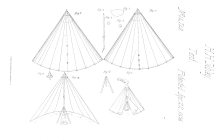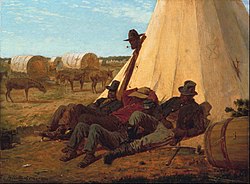Sibley tent

The Sibley tent was invented by the American officer Henry Hopkins Sibley , for which he received a patent in 1856. The tent has the shape of a cone, is approx. 4 m high and has a diameter of approx. 6 m. It is intended for an occupancy of 12 people.
The Sibley design differs from other pyramid tents in a number of details. The tent was held upright by a central pole that stood on an iron tripod that could be folded around the pole for transport. This reduced the length by half and made storage and transport easier. A fire for cooking and heating could be kindled under the tripod. The Sibley tent also did not need any guys as an external bracing, as the tent wall was sufficiently attached to the ground with 24 pegs. A sewn-in iron ring formed a round opening about 30 cm in size at the top, which had to be closed with a canvas cap in bad weather. The ring was hung on the central bar with chains. The use of a smoke opening above the central pole allowed good ventilation and smoke extraction, regardless of the wind direction.
history
The United States Patent and Trademark Office issued Patent No. 14,740 on April 22, 1856. The US Army only used this tent during the Utah War in the winter of 1857-58, and the design proved itself. Several Plains-Indian War veterans noted the tent's resemblance to tipis - the smoke hole, outside pegs, fire pit, etc.
Under the 1858 agreement with the War Department , Sibley would have received $ 5 for every tent made. But since Sibley left the US Army to join the Confederate States Army after the outbreak of the Civil War , he did not receive any royalties. The Union Army produced and used nearly 44,000 Sibley tents during the war.
After Sibley's death, his relatives tried unsuccessfully to claim royalties from the War Department.
Literature and Notes
- Billings, John D. Hardtack and Coffee: Or, The Unwritten Story of Army Life . Boston: George M. Smith & Co. (1887).
- Harrington, Charles, MD A Manual of Practical Hygiene, for Students, Physicians, and Medical Officers . Philadelphia: Lea Brothers & Co. (1902).
- Marcy, Randolph B., Capt. The Prairie Traveler: A Hand-Book for Overland Expeditions . New York: Harper & Brothers, Publishers (1859).
- Sibley, HH "Conical Tent", US Patent No. 14,740: United States Patent Office (April 22, 1856).
- ↑ a b Sibley, "Conical Tent"
- ^ Marcy, The Prairie Traveler , p. 143: "The tent used in the army will shelter comfortably twelve men."
- ^ Marcy, The Prairie Traveler , p. 142-143: "A tent has been invented by Major HH Sibley, of the army, which is known as the" Sibley tent. "It is somewhat similar to the Comanche lodge but, in place of the conical frame-work of poles, it has but one upright standard, resting upon an iron tripod in the center. The tripod can be used to suspend cooking utensils over the fire and, when folded up, admits the wooden standard between the legs, thereby reducing the length by half, and making it more convenient for packing and traveling. "
- ↑ Harrington, A Manual of Practical Hygiene , p. 601: "The English army uses the circular, or bell, tent. ... Formerly, the ventilation was practically nil , but now it has been somewhat improved."
- ^ Marcy, The Prairie Traveler , p. 143.
- ^ Marcy, The Prairie Traveler , Chapter V.
- ↑ Billings, Hardtack and Coffee , pp. 47-48: "The Sibley tent was invented by Henry Sibley, in 1857. He was a graduate of the United States military academy at West Point and accompanied Capt. John C. Fremont on one of his exploring expeditions. He evidently got his idea from the Tepee or Tepar — the Indian wigwam of poles covered with skins, and having a fire in the center — which he saw on the plains. "

